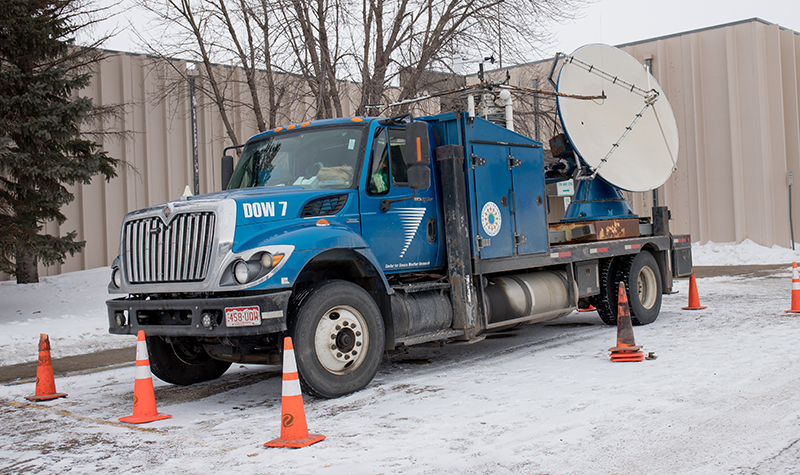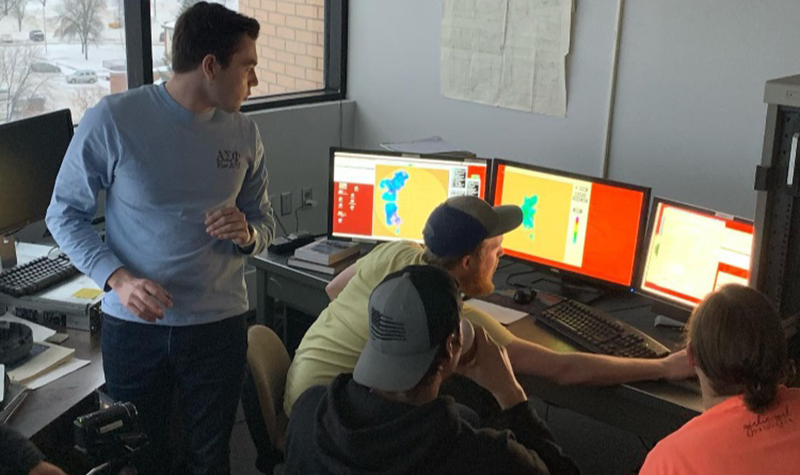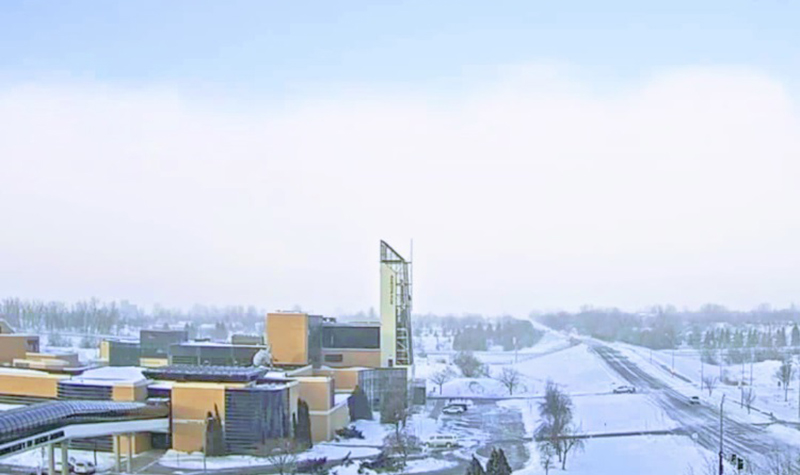17 Feb UND Student-driven winter weather field campaign faced dry, calm conditions until Wednesday storm proved fruitful

Aaron Kennedy, in yellow, has led a month-long field research campaign aiming to observe conditions around blizzards and blowing snow. On Wednesday, his team finally had a big break, leading them to launch weather balloons and fully deploy their range of tools and instruments. Image courtesy of UND Aerospace.
Hooray! A blizzard!
At last, a UND meteorology project got what its organizers had been hoping for: blowing snow, road closures and 50+ mph winds.
The great weather for the Grand Forks region over the past month had been bad news for Aaron Kennedy, associate professor of atmospheric sciences, and his National Science Foundation (NSF)-funded winter weather field campaign.
That’s because Kennedy’s project, titled Blowing Snow Observations at the University of North Dakota: Education through Research, aka BLOWN-UNDER, initially was met with a surprising lack of snow, blowing or otherwise, through its operational period of Jan. 20 to Feb. 10.
But Wednesday’s precipitation and blustery conditions proved to be the campaign’s big break.
The potential alone was great enough to keep the project’s linchpin instrument parked at UND past the Feb. 10 deadline.

The Doppler on Wheels has been on campus for the duration of the BLOWN-UNDER project, as well as some extra days to capture Wednesday’s blizzard event. It’s a high-tech, heavy duty, all-in-one, mobile weather station. Photo by Connor Murphy/UND Today.
Weather station on wheels
During the past month, Kennedy and his BLOWN-UNDER team have had access to a Doppler on Wheels (DOW), a high-tech, heavy-duty weather-radar truck that travels to tornado country, hurricane hotspots and other extreme-weather sites. The vehicle is operated by the Center for Severe Weather Research (CSWR), a Boulder, Colo.-based nonprofit largely funded by the National Science Foundation.
The Doppler on Wheels visiting UND is one of three operated by the CSWR. The fleet of radar-equipped trucks has been requested around the world for atmospheric data collection, though they’re best known for their tornadic storm chasing and on-site hurricane measurements.
The vehicle carries the capabilities of a weather station: instrument pods, ballooning probes and an 8-foot diameter radar dish as the metaphorical cherry on top.
It’s been ten years since UND has had access to a DOW for weather research. Coincidentally, it was last on campus while Kennedy was a graduate student in atmospheric sciences.
“And now I’m trying to return the favor to my students,” said Kennedy. “We’re having students involved at all levels.”
Kennedy, as the project’s supervisor, created five teams to be led by graduate students. In total, around 25 students, mostly undergraduates, have been involved in BLOWN-UNDER’s educational and outreach objectives.
On-site observation
The inspiration for the project is quite simple: North Dakota’s Red River Valley is the blowing snow capital of the country.
“The problem is this phenomenon isn’t in our weather models,” Kennedy said. “We try assuming different processes, but once the snow reaches the ground it doesn’t leave it, according to current models.”
The starting point for creating models is observation. With blowing snow happening so close to ground level, it’s hard to take measurements without actually being on-site. UND has a variety of in situ instruments deployed (some of which Kennedy secured for the project), but the Doppler on Wheels presents the best chance to bring every element together to collect meaningful data, Kennedy said.
Radar capabilities are a prime example. On the roof of Clifford Hall, the University operates a C-band radar, the National Oceanic and Atmospheric Administration operates an S-band radar outside of Mayville, N.D., and the DOW — able to locate itself in the middle of a weather event — is equipped with an X-band dish.
“Co-locating all the data from these three radars is called triple frequency observations, and you can do some pretty special stuff with that,” Kennedy said. With the ability to cast such a wide, data-collecting net, it was all up to the weather to provide a testbed.
Also, to be successful, everything needs to be working properly — quite a challenge in the dead of winter.

Members of the Radar Team worked on synchronizing UND’s rooftop radar with that of the Doppler on Wheels. Image courtesy of UND Aerospace.
Research in reality
With “Education through Research” in the project’s title, one of the primary motives of BLOWN-UNDER was to provide students with a true research experience.
Teams soon discovered that troubleshooting is a constant in the field.
“You get to learn that getting data is really hard sometimes,” said Nicole Loeb, the lead graduate student on the Surface Team. Loeb’s team has been learning about operating instruments on the ground, specifically at the Oakville Prairie field station west of Grand Forks.
“But working through those problems gives you a new respect for how things are recorded and everything that goes into getting data,” she said.
Kennedy wants all of his students to be exposed to field work more often, as many students came into the project expecting everything to be working and on a structured schedule.
“They need to understand that a lot of this work is by the seat of your pants, and flexibility is key,” Kennedy said.
Many of the technical difficulties stemmed from the DOW, which was stored in a hangar at UND Aerospace Flight Operations to be kept as warm as possible. In Kennedy’s words, the radars were either running or breaking for the Radar Team. But after the first week, the BLOWN-UNDER crew was ready for a weather event.

The BLOWN-UNDER team was able to reach hundreds of kids through visits to schools, as well as UND Aerospace Community Day. Educational outreach was a secondary objective of the field campaign. Image courtesy of UND Aerospace.
Outreach opportunities
Beyond a few flurries, though, the weather didn’t come for the first few weeks. Luckily, that opened the door to fulfilling the project’s secondary objective: outreach. The Doppler on Wheels visited a number of schools in the area, and on UND’s Aerospace Community Day, the vehicle’s spinning radar dish was the first thing people saw when they stepped off the bus at the University’s airport facilities. Hundreds of kids have been through the DOW during the past month.
The outreach component is almost as crucial as the data collection, as it can open the eyes of young people to things that may not be taught at school, Loeb said. She sat in the DOW during Community Day and saw enthusiasm from people of all ages.
“I think it’s important because when I was growing up, I didn’t know that weather was an option for careers, or what a weather person actually does,” Loeb said. “It’s cool to go to kids and talk about what we do and what they, too, can do one day.”
Also during the relatively calm weather, the team was still able to execute a couple of test deployments to reinforce training, test equipment and evaluate the communication necessary to execute their mission.
Alec Sczepanski, the lead on the Balloon Team, has been teaching undergraduates how to launch weather balloons, and also has been learning about launching a more advanced probe that can capture imagery of precipitation and particles. Most instrumentation packages carried by balloons capture standard meteorological variables. But the Particle Size Imaging and Velocity Probe goes a step further by letting the team verify what the DOW is trying to scan from the ground.
The PASIV, provided by the National Severe Storms Laboratory, is a lightweight but large package that requires a big balloon. Launching a balloon in high winds and snowy conditions is essentially uncharted territory.
Nevertheless, in the early hours of Wednesday, Sczepanski (with the help of seven others) successfully launched the PASIV payload into the gusting winds near Clifford Hall.
“We’re hoping to collect data that nobody’s collected before, so that will be a learning experience for everyone,” Sczepanski said. “Being part of a groundbreaking campaign has been so exciting and so much fun.”

The perspective of UND’s Skycam, found on the Atmospheric Sciences YouTube page, shows Wednesday’s blizzard conditions at around 8:50 a.m.
Perfect storm
Kennedy was happy to report that Wednesday’s class-cancelling conditions were the “home run case” BLOWN-UNDER was looking for.
Despite little snow, an extremely strong Arctic front brought ground blizzard conditions to the Red River Valley. For the first time, the team could successfully launch balloons and monitor ground instruments while all three radars scanned a blizzard, Kennedy said.
The Doppler on Wheels operated from about 10 p.m. Tuesday to 8 a.m. Wednesday, gathering data during the worst of the storm. Ultimately, the equipment’s hydraulics and generator couldn’t cope with the cold and wind. But that didn’t happen until researchers had gathered what may be “the most comprehensive observations of a ground blizzard yet,” Kennedy said.
Kennedy also thanked the Center for Severe Weather Research for extending the DOW’s deployment at UND’s request.
Follow the story
Media Team lead Kaela Lucke has been working with students to produce media coverage around the campaign, including video production, writing and social media posting.
She said their team’s content can be found on the UND Atmospheric Sciences Facebook page as well as the department’s Twitter and Instagram pages.


